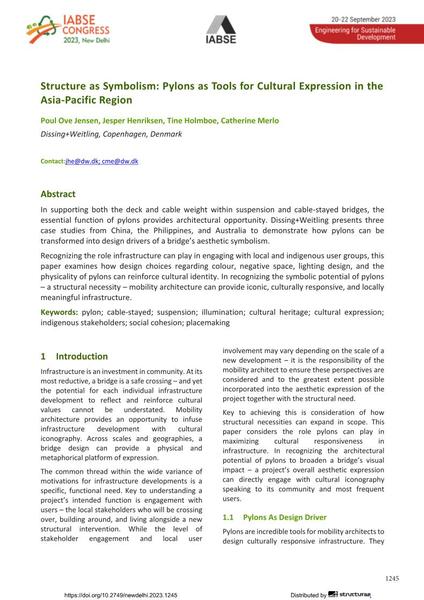Structure as Symbolism: Pylons as Tools for Cultural Expression in the Asia-Pacific Region

|
|
|||||||||||
Bibliographic Details
| Author(s): |
Poul Ove Jensen
(Dissing+Weitling, Copenhagen, Denmark)
Jesper Henriksen (Dissing+Weitling, Copenhagen, Denmark) Tine Holmboe (Dissing+Weitling, Copenhagen, Denmark) Catherine Merlo (Dissing+Weitling, Copenhagen, Denmark) |
||||
|---|---|---|---|---|---|
| Medium: | conference paper | ||||
| Language(s): | English | ||||
| Conference: | IABSE Congress: Engineering for Sustainable Development, New Delhi, India, 20-22 September 2023 | ||||
| Published in: | IABSE Congress New Delhi 2023 | ||||
|
|||||
| Page(s): | 1245-1252 | ||||
| Total no. of pages: | 8 | ||||
| DOI: | 10.2749/newdelhi.2023.1245 | ||||
| Abstract: |
In supporting both the deck and cable weight within suspension and cable-stayed bridges, the essential function of pylons provides architectural opportunity. Dissing+Weitling presents three case studies from China, the Philippines, and Australia to demonstrate how pylons can be transformed into design drivers of a bridge’s aesthetic symbolism. Recognizing the role infrastructure can play in engaging with local and indigenous user groups, this paper examines how design choices regarding colour, negative space, lighting design, and the physicality of pylons can reinforce cultural identity. In recognizing the symbolic potential of pylons – a structural necessity – mobility architecture can provide iconic, culturally responsive, and locally meaningful infrastructure. |
||||
| Keywords: |
pylon suspension cultural heritage illumination cable-stayed social cohesion placemaking cultural expression indigenous stakeholders
|
||||
